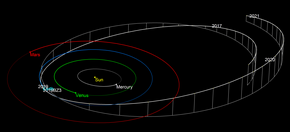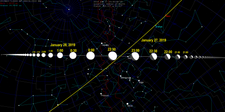 Orbit of 2019 BZ3, before and after 2019 flyby with 30 day motion Orbit of 2019 BZ3, before and after 2019 flyby with 30 day motion | |
| Discovery | |
|---|---|
| Discovered by | MLS |
| Discovery site | Mount Lemmon Obs. |
| Discovery date | 28 January 2019 (first observed only) |
| Designations | |
| MPC designation | 2019 BZ3 |
| Minor planet category | NEO · Apollo |
| Orbital characteristics | |
| Epoch 27 April 2019 (JD 2458600.5) | |
| Uncertainty parameter 7 · 5 | |
| Observation arc | 8 days |
| Aphelion | 3.6251 AU |
| Perihelion | 0.9591 AU |
| Semi-major axis | 2.2921 AU |
| Eccentricity | 0.5815 |
| Orbital period (sidereal) | 3.47 yr (1,268 d) |
| Mean anomaly | 30.064° |
| Mean motion | 0° 17 2.4 / day |
| Inclination | 10.631° |
| Longitude of ascending node | 127.44° |
| Argument of perihelion | 338.22° |
| Earth MOID | 0.0004575 AU (0.18 LD) |
| Physical characteristics | |
| Mean diameter | 6 m (est. at 0.15) |
| Apparent magnitude | 17.9 (brightest) |
| Absolute magnitude (H) | 28.8 28.719 |
2019 BZ3 is a very small near-Earth asteroid of the Apollo group, approximately 6 meters (20 feet) in diameter. It was first observed by the Mount Lemmon Survey on 28 January 2019, just hours after the asteroid's sub-lunar flyby of Earth at less than 0.12 lunar distance.
Orbit and classification
 Path across sky, 30 minute motion
Path across sky, 30 minute motion Hourly motion moon's orbit
Hourly motion moon's orbit
2019 BZ3 is an Apollo asteroid, the largest subgroup of near-Earth objects. It orbits the Sun at a distance of 0.96–3.6 AU once every 3 years and 6 months (1,268 days; semi-major axis of 2.29 AU). Its orbit has a high eccentricity of 0.58 and an inclination of 11° with respect to the ecliptic. The body still has a high orbital uncertainty of 5 and 7, respectively. Its observation arc of only 8 days begins with its official first observation at Mount Lemmon Observatory on 28 January 2019.
Close approaches
2019 BZ3 has an Earth minimum orbital intersection distance of 0.000457 AU (68,000 km), which corresponds to 0.18 lunar distances (LD). Due to its very small size, however, 2019 BZ3 is not a potentially hazardous asteroid, which are required to be approximately 140 meters (460 ft) in diameter, that is, to be brighter than an absolute magnitude of 22.
- Flybys
On 27 January 2019 at UTC 23:29, 2019 BZ3 passed Earth at a nominal distance of 48,130 km (0.125 LD) with a relative velocity of 11.37 km. Six hours later, it flew by the Moon at 350400 km. The object's next close approaches will occur on 17 December 2025 at a much greater distance of 56 LD (0.143 AU), and on 29 January 2085 at 5.5 LD (0.0142 AU).
Numbering and naming
This minor planet has not yet been numbered by the Minor Planet Center and remains unnamed.
Physical characteristics
2019 BZ3 has an undetermined spectral type. Based on a generic magnitude-to-diameter conversion, the asteroid measures approximately 6 meter in diameter for an assumed albedo of 0.15 and absolute magnitude 28.8. The estimated diameter may vary between 5 and 10 meters depending on whether an albedo for a dark carbonaceous (0.05) or a bright stony (0.25) asteroid is assumed.
See also
References
- ^ "2019 BZ3". Minor Planet Center. Retrieved 11 January 2020.
- ^ "JPL Small-Body Database Browser: (2019 BZ3)" (2019-02-05 last obs.). Jet Propulsion Laboratory. Retrieved 11 January 2020.
- ^ "Asteroid Size Estimator". CNEOS NASA/JPL. Retrieved 11 January 2020.
- ^ Blašković, Teo (29 January 2019). "Asteroid 2019 BZ3 flew past Earth at 0.13 lunar distances". Watchers.news. Retrieved 11 January 2020.
- "Asteroid 2019 BZ3 – Close approaches". AstDyS-2, Asteroids – Dynamic Site. Retrieved 11 January 2020.
External links
- 2019 BZ3 -- Very small Apollo-class Asteroid, spacereference.org
- 2019 BZ3 Geometry, International Asteroid Warning Network
- MPEC 2019-B142: 2019 BZ3, MPC, 2019 Jan. 29, 12:24 UT
- Near-Earth Object Observations Program, 24 NASA, June 2019
- Asteroid Lightcurve Database (LCDB), query form (info Archived 16 December 2017 at the Wayback Machine)
- 2019 BZ3 at NeoDyS-2, Near Earth Objects—Dynamic Site
- 2019 BZ3 at ESA–space situational awareness
- 2019 BZ3 at the JPL Small-Body Database
| Small Solar System bodies | |||||||
|---|---|---|---|---|---|---|---|
| Minor planets |
| ||||||
| Comets | |||||||
| Other | |||||||